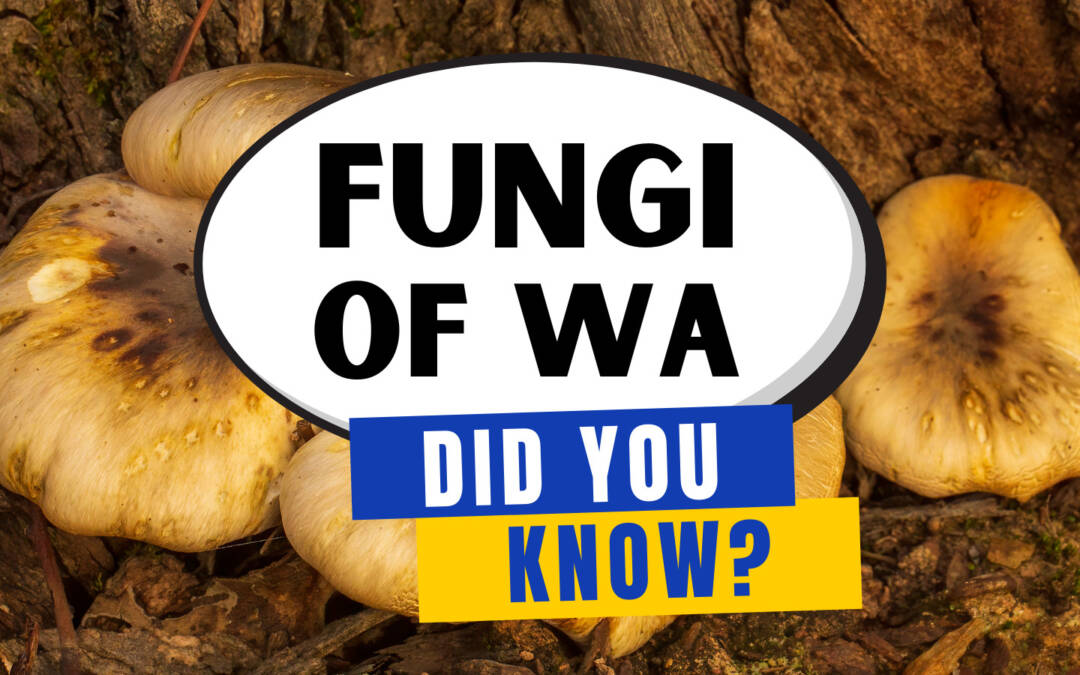In the “Tree of Life”, fungi were traditionally classed as plants. However, nowadays, specialists explain that they are more closely related to the Animal Kingdom than the Plant Kingdom. Ecologist Robert Whittaker first proposed that Fungi have emerged to have their own kingdom because they acquire nutrients in a unique way through the secretion of digestive enzymes rather than through photosynthesis like most plants do. Figure 1 represents the five kingdoms proposed by Whittaker in his 1969 article in Science, highlighting the various modes of obtaining nutrition (Brian Lovett 2021).
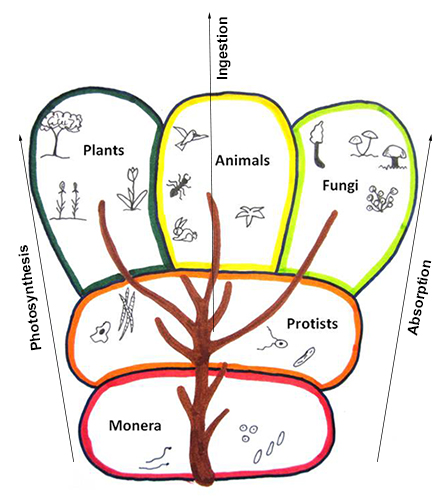
Fungal species are diverse, with many unique properties: some are innocuous, some useful, and some are harmful. They participate in critical processes for environmental sustainability by effectively uniting soils, plants and animals to create a cohesive and healthy system. This process involves carrying nutrients by capturing, storing, releasing and recycling carbon through their vast network of threads.
Fungi are estimated to contribute to 25% of the total biomass on Earth. Approximately 250,000 fungi species (estimated between only about 5-10% of the potential existing species) have been catalogued in Australia, including microorganisms like mould, yeast, and mushrooms. Australia also has many endemic truffles and is home to the bona fide truffle capital of the world. It is estimated around 1,200-2,400 truffle species exist within Australia, but only 10-25% are known so far (Bougher 2009).
Benefits of fungi range from providing essential nutrients to plants to medical improvements, environmental protection and restoration and improved efficiency in agriculture. Fungi can also be used in the production of chemicals and the drug manufacturing industries.
Western Australia Fungi
The fungus tradition goes back a long time in Western Australia. For thousands of years, Aboriginal fungal lore and knowledge have been passed through generations. Records began in the 19th century when various European settlers and explorers recorded Aboriginal uses and beliefs about fungi. The first records about Fungi were in 1841 when explorer George Grey published an account of his travels in Western Australia and reported that he’d seen seven species of fungi eaten by the Aborigines (Herbarium 2013).

Western Australia has an estimated population of about 140,000 fungi species. While many areas in Perth have not been surveyed for fungi, some detailed surveys have been undertaken. Bold Park, one of Perth’s major inner-urban bushlands (437 hectares), is an area that has been surveyed with over 350 species of macrofungi recorded. Specialists believe other urban bushland areas, such as Kings Park, may also be host to a large number of fungi species (Bougher 2009).
Fungi may fruit at any time of the year in temperate regions. However, within the Perth region, there are two distinct periods (Bougher, Neale L. 2017):
- February to April: Warm, humid days coinciding with bursts of rain or humidity will often entice the fruiting bodies of some fungi to appear. In this period, you can have fun by trying to locate some species of Fungi in WA, for example, the Truffle Orphans (Known as “black gold”), of course with a trained Truffle Dog supporting you. But, if you want to collect fungi on public land, remember, fungi are protected in Western Australia under the Wildlife Conservation Act 1950. You will need a licence from the Department of Environment and Conservation (DEC).
- May to July: In Perth’s natural bushlands, most fungal fruiting bodies do not appear until after the onset of substantial autumn rains. This time is usually the fruitful period to search for bushland fungi.
Australia has become the world’s fourth-largest producer of the most-prized black gold truffle, and the small town of Manjimup, situated east of Margaret River in WA, is known as the bona fide truffle capital of Australia. The region is accountable for around 85 per cent of our annual crop. The richness of the soil, along with the cool climate, make it perfect for growing the beloved fine-dining staple (Bougher, Neale L. 2017).
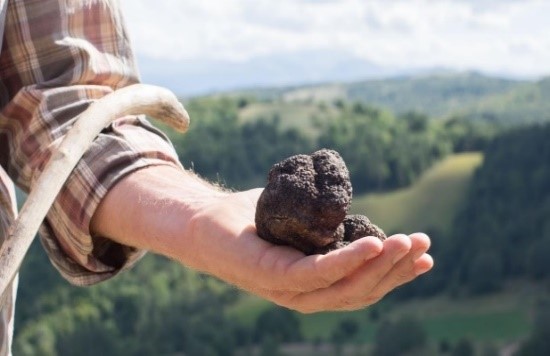
Fungi Risks and Benefits to the Environment and People
An example of how fungi can be harmful to the environment is the Phytophthora cinnamomi, commonly known as “the biological bulldozer”. It is listed as a critical threat to species under the Commonwealth Environment Protection and Biodiversity Conservation Act 1999 (EPBC Act) (Commonwealth of Australia 2017). Phytophthora cinnamomi is a soil-borne plant pathogen that causes the disease Phytophthora dieback. It destroys native forests, bushland grasslands and orchards around the world. It destroys entire plant communities and can cause the extinction of plant species in South West of Western Australia, where more than 40 per cent of native plants are susceptible to the disease (WA 2021). The area of land infected in Western Australia by Phytophthora dieback is equivalent to over one million hectares. There is no known cure for Phytophthora dieback; however, some possible management methods include (UC IPM 2017):
- Sanitation (helping soil or water to not move from infested areas),
- raised plant beds,
- crop rotation,
- soil solarisation,
- soil conditions,
- and establishing a barrier.
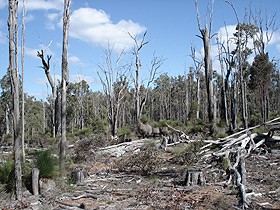
Another dangerous fungus is the “Marbled Death Cap mushrooms”, which in 2016, was found growing in Denmark – WA (Department of Health, Western Australia 2021). The Marbled Death Cap (Amanita marmorata) looks similar to the edible, non-toxic field mushroom (Agaricus sp.) found in many supermarkets or greengrocers, however it can be potentially deadly. It is a large mushroom with a marbled white, greyish or brownish cap and white gills underneath; the poison is in the cap, gills, stem and spores. After initial consumption, gastro-intestinal symptoms usually develop within 6 to 24 hours, and in some cases, death can occur within as little as 48 hours (Department of Health, Western Australia 2021). Mortality rates from Death Cap mushrooms are around 50 per cent.
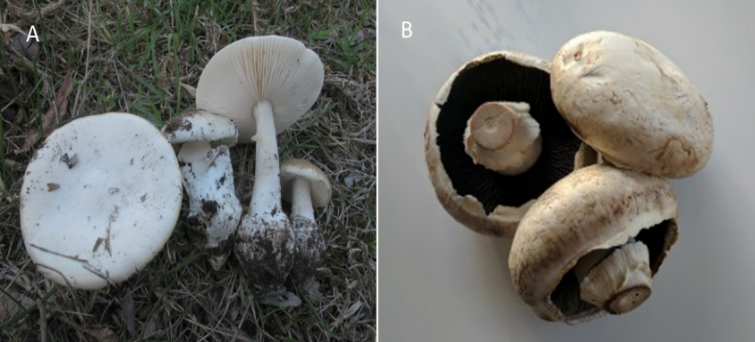
Although some fungi can be harmful to the environment and people, you do not need to worry. You can stay informed through programmes that support and protect us from the problems caused by these species, such as Fungimap. Fungimap is a national, non-profit citizen-science group formed in the mid-1990s to enable individuals with knowledge of their local fungi, to share that knowledge within the scientific community and help fill the gap in our understanding of fungi. Fungal surveys will help confirm the distributions and habitats of species already well-recorded, locate and document new species, and contribute to our understanding of how fungi are likely to respond under threat. You can access their website through the link https://fungimap.org.au/. Another institute helping in the challenge to identify and monitor Fungi through the records and images observatory portal is the Atlas of Living Australia (www.ala.org.au).
In fact, fungi can contribute many benefits to the environment, for example (Bougher 2009):
- They can recycle 85% of the carbon from dead organic matter and release the locked-up nutrients by breaking down and absorbing nutrients from dead organic matter, including leaf litter, soil, dung, wood, and dead animals;
- Fungi have mutually beneficial partnerships with many plants. Fungal networks act as an extra root system as they can capture nutrients in the soil distant from roots. The fungi transform and transport nutrients from the soil and deliver them to plant roots.
- The fungi benefit from this partnership as the plants supply sugars to them. In Australia, hundreds of plants take advantage of this partnership with fungi such as eucalypts, sheoaks, wattles, orchids, and poison peas.
- Fungi are eaten by myriads of small soil animals such as insects which are essential to soil organic matter, and the food web, which in turn feeds larger animals and birds. Australia’s most endangered mammal, Gilbert’s potoroo, is almost 100% dependent on fungi as food.
Australia also has a good history with Medicinal Fungus. The well-known antibiotic drug penicillin is derived from the fungus Penicillium. Penicillins are a group of antibacterial drugs that attack a wide range of bacteria. They were the first drugs of this type that doctors used. The discovery and manufacture of penicillins have changed the face of medicine, as these drugs have saved millions of lives. Figure 6 shows the step by step manufacturing process to produce Penicillin. More recently, Australia’s first legal collection of native “Psychedelic Renaissance” mushrooms could provide medical options to treat severe depression, alcohol and drug addiction and post-traumatic stress disorder (PTSD).
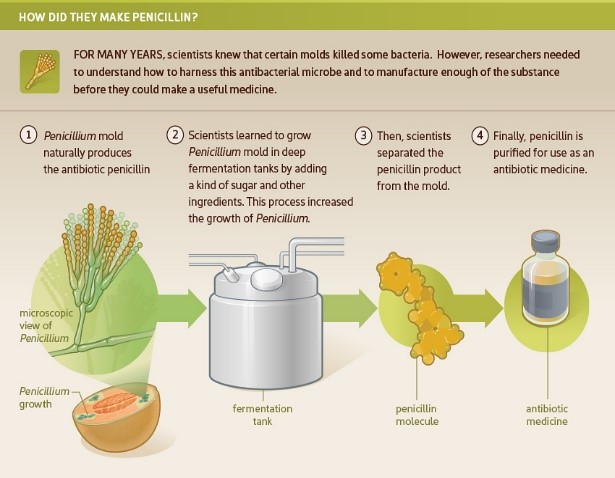
Agriculture is another sector that has been developing and taking advantage of “fungi’s special abilities”. There are many research programs across the globe and in WA that intend to improve agriculture:
- “Hostile fungus found to protect against cereal diseases” – led by Huazhong Agricultural University, Professor Dahong Jiang found that the beneficial endophyte fungus effectively protected cereal plants against multiple fungal diseases and increased the growth and yield of crops in-field. It reduced Fusarium Head Blight in wheat by up to 60% in numerous field trials in China and provided adequate protection against rice blast and wheat stripe rust diseases (Jiang 2020).
- “The Native Fungis Austroboletus occidentallis as a biofertiliser” – A research program from the UWA, by Dr Khalil Kariman, plans to characterise the crop benefits of the novel biofertiliser under field conditions. The research focuses on enhancing crop nutrition, particularly phosphorus and nitrogen, and stress tolerance in dry areas. The biofertiliser made from Austroboletus occidentalis, provides host plant growth and nutritional benefits by releasing nutrients in the soil without forming mycorrhizal structures in roots. Previous glasshouse experiments demonstrated the fungus increased canola shoot biomass and grain yield by 20% in field soils containing a high level of phosphorus (Kariman 2020).
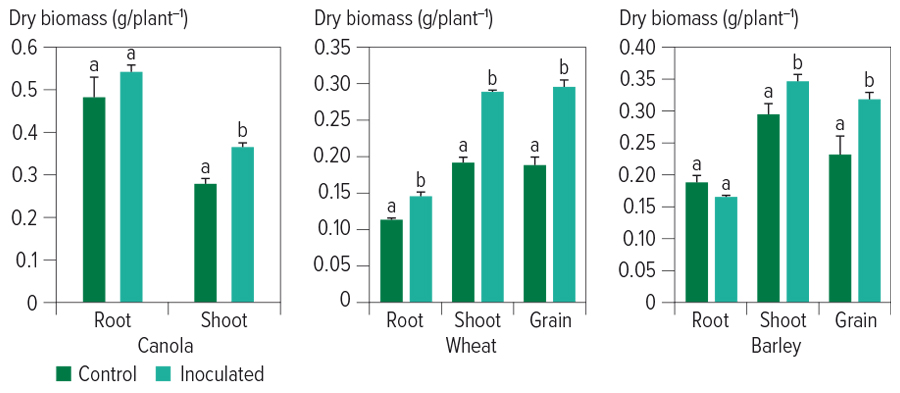
The importance of Fungi in our ecosystems cannot be undervalued. Unfortunately, there is a whole lot that we are yet to discover about our local fungi species and their impact. The assessment of Fungi is complex and needs professionals qualified to analyse any environmental impact generated. Thus, if you or your organisation would like to develop a research or report about Biodiversity or conduct an environmental impact assessment, Integrate Sustainability may be able to help. Please contact us by email at enquiries@integratesustainability.com.au or call us on 08 9468 0338.
References
Reuter, Courtney. 2000. Phytophthora cinnamomi Rands. Accessed 10 01, 2021. https://projects.ncsu.edu/cals/course/pp728/cinnamomi/p_cinnamomi.htm.
Bougher, Neale L. 2017. “Fungi of the Perth Region and Beyond.” Western Australian Naturalists‟ Club (Inc.). www.fungiperth.org.au.
Bougher, Neale L. 2009. “PUBF Fungi Manual.” Perth Urban Bushland Fungi Project (2009 Bush Skills for the Hills Workshop). www.fungiperth.org.au.
Brian Lovett, Ph.D. 2021. American Society for Microbiology – Three Reasons Fungi Are Not Plants. 06 01. Accessed 10 05, 2021. https://asm.org/Articles/2021/January/Three-Reasons-Fungi-Are-Not-Plants.
Commonwealth of Australia. 2017. Background: Threat abatement plan for disease in natural ecosystems caused by Phytophthora. Canberra: © Copyright Commonwealth of Australia.
Department of Health, Western Australia. 2021. Department of Health, Western Australia. 01 10. Accessed 10 01, 2021. https://www.healthywa.wa.gov.au/Articles/J_M/Marbled-Death-Cap-mushrooms.
Herbarium, Australian National. 2013. Australian National Botanic Gardens and Australian National Herbarium, Canberra. 23 01. Accessed 10 01, 2021. https://www.anbg.gov.au/fungi/aboriginal.html.
Industry, DNA to Beer: Harnessing Nature in Medicine &. 2021. National Library of Medicine. 10. Accessed 10 05, 2021. https://www.nlm.nih.gov/exhibition/fromdnatobeer/exhibition-interactive/illustrations/penicillin-alternative.html.
Jiang, Dahong. 2020. “Hostile fungus found to protect against cereal diseases.” The ISME Journal – Huazhong Agricultural University. https://www.uwa.edu.au/news/article/2020/september/hostile-fungus-found-to-protect-against-cereal-diseases.
Kariman, Khalil. 2020. groundcover. 02 12. Accessed 10 01, 2021. https://groundcover.grdc.com.au/agronomy/soil-and-nutrition/biofertiliser-potential-in-native-fungus.
Nichols, Jennifer. 2021. ABC News. 30 08. Accessed 10 03, 2021. https://www.abc.net.au/news/rural/2021-08-30/magic-mushroom-research/100413396.
UC IPM. 2017. Avocado Phytophthora Root Rot. 12 12. Accessed 10 01, 2021. https://web.archive.org/web/20180129004313/http://ipm.ucanr.edu/PMG/r8100111.html#MANAGEMENT.
WA, Parks and Wildlife Service. 2021. Department of Biodiversity, Conservation and Attractions – Parks and Wildlife Service. 04 10. Accessed 10 04, 2021. https://www.dpaw.wa.gov.au/management/pests-diseases/phytophthora-dieback.

